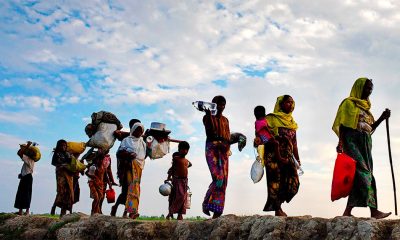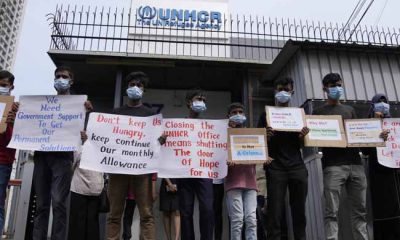Foreign News
Tensions rise as two more boats with over 300 Rohingya land in Indonesia

Over 300 Rohingya refugees have arrived on the coast of Aceh province in Indonesia after weeks of drifting across the sea from Bangladesh.
The emaciated survivors – children, women and men – told of running out of supplies and of fearing death at sea as they landed on the unwelcoming shores of the villages of Pidie and Aceh Besar in the pre-dawn hours of Sunday morning.
“The boat was sinking. We had no food or water left,” told Shahidul Islam, a 34-year-old survivor, saying he had left from a refugee camp in Bangladesh.
A group of 180 refugees arrived by boat at 3am local time (20:00 GMT on Saturday) on a beach in the Pidie regency of Aceh province. The second boat carrying 135 refugees landed in neighbouring Aceh Besar regency hours later after being adrift at sea for more than a month, while a third boat is missing.
“We just want to find somewhere safe,” one refugee told Al Jazeera at a shelter on the coast. “We knew that we might die at sea, but finally we are safe. That’s all we want for our children.”
On Sunday evening, Aceh Besar’s acting regent Muhammad Iswanto said the refugees were transferred to a temporary shelter during the visit of a United Nations representative. “They are relocated to the camping ground by the province’s [refugee] task force. They will join other Rohingya refugees that have been there,” said the official.
Nearly a million Rohingya live in refugee camps in Bangladesh’s Cox’s Bazar near its border with Myanmar, most after fleeing a military-led crackdown and alleged acts of genocide in Myanmar in 2017. Thousands of them risk their lives each year on long and expensive sea journeys, often in flimsy boats that sail from Bangladesh, to try to reach Malaysia or Indonesia.
But the mainly Muslim minority who fled Myanmar after persecution has not found refuge in these communities, where local villagers have tried to push refugee boats back to sea.
While the people of Aceh in Indonesia had previously welcomed refugees, tensions have been escalating as the number of arrivals has grown.
Over 1,500 Rohingya have arrived in Indonesia since last month after taking perilous journeys across the sea.
The residents in Aceh say they will neither provide funds nor supplies or shelter for the arriving Rohingya nor do they want them to stay in the area.
The local government in Pidie said earlier it would not take responsibility for providing the refugees with tents, or other basic needs, or “bear any expenses”.
Rijalul Fitri, head of Blang Raya village in Aceh, said on Sunday they do not want the refugees in their village. “We stayed up all night so as not to allow them to dock, but they arrived,” he said.
Fitri was adamant that the refugees must relocate. “They can’t stay here,” he said.
Over 100 protesters in Sabang Island in Aceh, where there is a temporary shelter, clashed with police as they called for the Rohingya refugees to be relocated.
“It’s one boat after another,” one woman told Al Jazeera. “We are poor people, why don’t they use the money to help us? Why are they giving them food?” she said, referring to volunteers distributing food and water to the refugees.
“We reject the Rohingya,” another protester said. “We want them to be moved as soon as possible. We don’t want to catch the diseases they carry,” he said.
The UN refugee agency’s protection associate Faisal Rahman said the organisation has been trying to reassure the local communities.
“We continue to explain the situation to the people and ensure that they will not be burdened with the handling of refugees,” he said, acknowledging that designated shelters were over-capacity.
But “the government is working to provide shelter as the number of refugees arriving is very high”, Rahman said.
Indonesian President Joko Widodo on Friday said temporary relief would be provided for refugees “with a priority on the interests of the local community”.
Indonesia’s government says it is looking for a new site to house the refugees, and has acknowledged the opposition from residents in its goal to find a sustainable solution, Al Jazeera correspondent Jessica Washington reported from Jakarta.
The UN says the difficult conditions and increase in crime in Bangladesh as well as the worsening crisis in Myanmar is the reason for the increase in the flow of refugees, with experts predicting more boats could arrive in the coming months.
“Around 75 percent of the new arrivals are women and children,” Emily Bojovic of the UN refugee agency’s Southeast Asia office told Al Jazeera.
(Aljazeera)
Foreign News
Nasa ‘Earthrise’ astronaut dies at 90 in plane crash

Apollo 8 astronaut Bill Anders, who snapped one of the most famous photographs taken in outer space, has died at the age of 90.
Officials say a small plane he was flying crashed into the water north of Seattle, Washington.
Anders’ son Greg confirmed that his father was flying the small plane, and that his body was recovered on Friday afternoon. “The family is devastated. He was a great pilot. He will be missed,” a statement from the family reads.
Anders – who was a lunar module pilot on the Apollo 8 mission – took the iconic Earthrise photograph, one of the most memorable and inspirational images of Earth from space.
Taken on Christmas Eve during the 1968 mission, the first crewed space flight to leave Earth and reach the Moon, the picture shows the planet rising above the horizon from the barren lunar surface.
Anders later described it as his most significant contribution to the space programme.

The image is widely credited with motivating the global environmental movement and leading to the creation of Earth Day, an annual event to promote activism and awareness of caring for the planet.
Speaking of the moment, Anders said: “We came all this way to explore the Moon, and the most important thing that we discovered was the Earth.”
Officials said on Friday that Anders crashed his plane around 11:40PDT (1940BST).
The US National Transportation Safety Board (NTSB) said the 90-year-old was flying a Beechcraft A A 45 – also known as a T-34. The agency said that the plane crashed about 80ft (25m) from the coast of Jones Island.
Anders also served as the backup pilot to the Apollo 11 mission, the name of the effort that led to the first Moon landing on July 24, 1969.
Following Anders’ retirement from the space programme in 1969, the former astronaut largely worked in the aerospace industry for several decades. He also served as US Ambassador to Norway for a year in the 1970s.
But he is best remembered for the Apollo 8 mission and the iconic photograph he took from space.
“In 1968, during Apollo 8, Bill Anders offered to humanity among the deepest of gifts an astronaut can give. He traveled to the threshold of the Moon and helped all of us see something else: ourselves,” Nasa Administrator Bill Nelson said in a statement.
Mark Kelly, a former astronaut who now serves as a US Senator for the state of Arizona, said in a post on X, formerly Twitter, that Anders “inspired me and generations of astronauts and explorers. My thoughts are with his family and friends”.
[BBC]
Foreign News
China’s Chang’e-6 lifts off from far side of Moon with rock samples

A Chinese spacecraft carrying rock and soil samples from the far side of the Moon has lifted off from the lunar surface to start its journey back to Earth, according to state media.
The achievement on Tuesday is a world first and the latest leap for Beijing’s decades-old space programme, which aims to send a crewed mission to the Moon by 2030.
The Xinhua News Agency, citing the China National Space Administration (CNSA), said that the ascender of the Chang’e-6 probe took off at 7:38am local time on Tuesday (23:38 GMT) and entered a preset orbit around the moon.
It described the move as “an unprecedented feat in human lunar exploration history”.
The Chang’e-6 probe was launched last month and its lander touched down on the far side of the Moon on Sunday. It used a drill and robotic arm to dig up soil on and below the Moon’s surface, according to Xinhua.
After successfully gathering its samples, the Chang’e-6 unfurled China’s national flag for the first time on the far side of the Moon, it said.
The agency cited the CNSA as saying that the spacecraft stowed the samples it had gathered in a container inside the ascender of the probe as planned.
[Aljazeera]
Foreign News
China says its spacecraft lands on Moon’s far side

China says its uncrewed craft has successfully landed on the far side of the Moon – an unexplored place almost no-one tries to go.
The Chang’e 6 touched down in the South Pole-Aitken Basin at 06:23 Beijing time on Sunday morning (22:23 GMT Saturday), the China National Space Administration (CNSA) said.
Launched on 3 May, the mission aims to collect precious rock and soil from this region for the first time in history. The probe could extract some of the Moon’s oldest rocks from a huge crater on its South Pole.
The landing was fraught with risks, because it is very difficult to communicate with spacecraft once they reach the far side of the Moon. China is the only country to have achieved the feat before, landing its Chang’e-4 in 2019.
After launching from Wenchang Space Launch Center, the Chang’e 6 spacecraft had been orbiting the Moon waiting to land. The lander component of the mission then separated from the orbiter to touch down on the side of the Moon that faces permanently away from Earth.
During the descent, an autonomous visual obstacle avoidance system was used to automatically detect obstacles, with a visible light camera selecting a comparatively safe landing area based on the brightness and darkness of the lunar surface, the CNSA was quoted as saying by state-run Xinhua news agency.
The lander hovered about 100m (328ft) above the safe landing area, and used a laser 3D scanner before a slow vertical descent. The operation was supported by the Queqiao-2 relay satellite, the CNSA said.
Chinese state media described the successful landing as an “historic moment”. The state broadcaster said “applause erupted at the Beijing Aerospace Flight Control Center” when the Chang’e landing craft touched down on the Moon early on Sunday morning.
The lander should spend up to three days gathering materials from the surface in an operation the CNSA said would involve “many engineering innovations, high risks and great difficulty”. “Everyone is very excited that we might get a look at these rocks no-one has ever seen before,” explains Professor John Pernet-Fisher, who specialises in lunar geology at the University of Manchester.
He has analysed other lunar rock brought back on the American Apollo mission and previous Chinese missions. But he says the chance to analyse rock from a completely different area of the Moon could answer fundamental questions about how planets form.
Most of the rocks collected so far are volcanic, similar to what we might find in Iceland or Hawaii. But the material on the far side would have a different chemistry . “It would help us answer those really big questions, like how are planets formed, why do crusts form, what is the origin of water in the solar system?” the professor says.
The mission aims to collect about 2kg (4.4lb) of material using a drill and mechanical arm, according to the CNSA.
The South Pole–Aitken basin, an impact crater, is one of the largest known in the solar system.
From there, the probe could gather material that came from deep inside the lunar mantle – the inner core of the Moon – Prof Pernet-Fisher says.
The Moon’s South Pole is the next frontier in lunar missions – countries are keen to understand the region because there is a good chance it has ice.

The capsule in the last Chinese moon mission, Chang’e 5, brought back soil and rocks in 2020 (BBC)
Access to water would significantly boost the chances of successfully establishing a human base on the Moon for scientific research.
If the mission succeeds, the craft will return to Earth with the precious samples on board a special return capsule.
The material will be kept in special conditions to try to keep it as pristine as possible.
Scientists in China will be given the first chance to analyse the rocks, and later researchers around the world will be able to apply for the opportunity too.
This is the second time China has launched a mission to collect samples from the Moon.
In 2020 Chang’e 5 brought back 1.7kg of material from an area called Oceanus Procellarum on the Moon’s near side.
China is planning three more uncrewed missions this decade as it looks for water on the Moon and investigates setting up a permanent base there.
Beijing’s broader strategy aims to see a Chinese astronaut walk on the moon by around 2030.
The US also aims to put astronauts back on the moon, with Nasa aiming to launch its Artemis 3 mission in 2026.
(BBC)




















